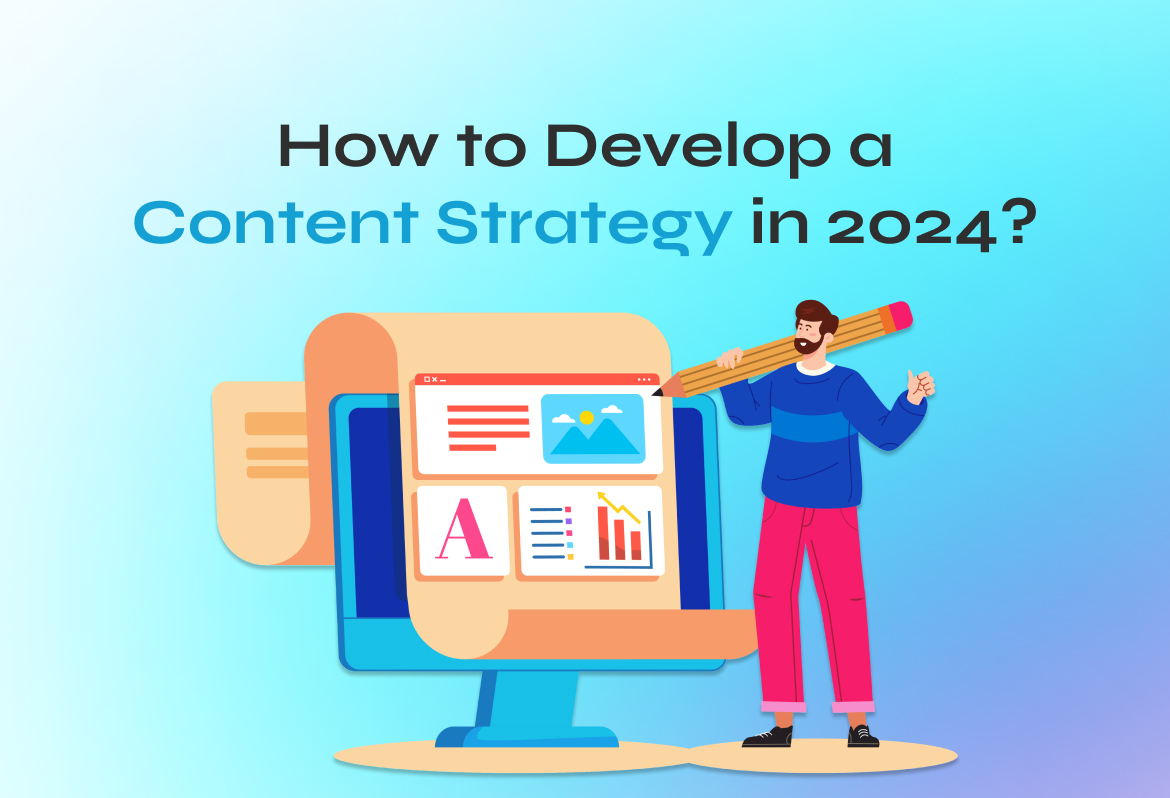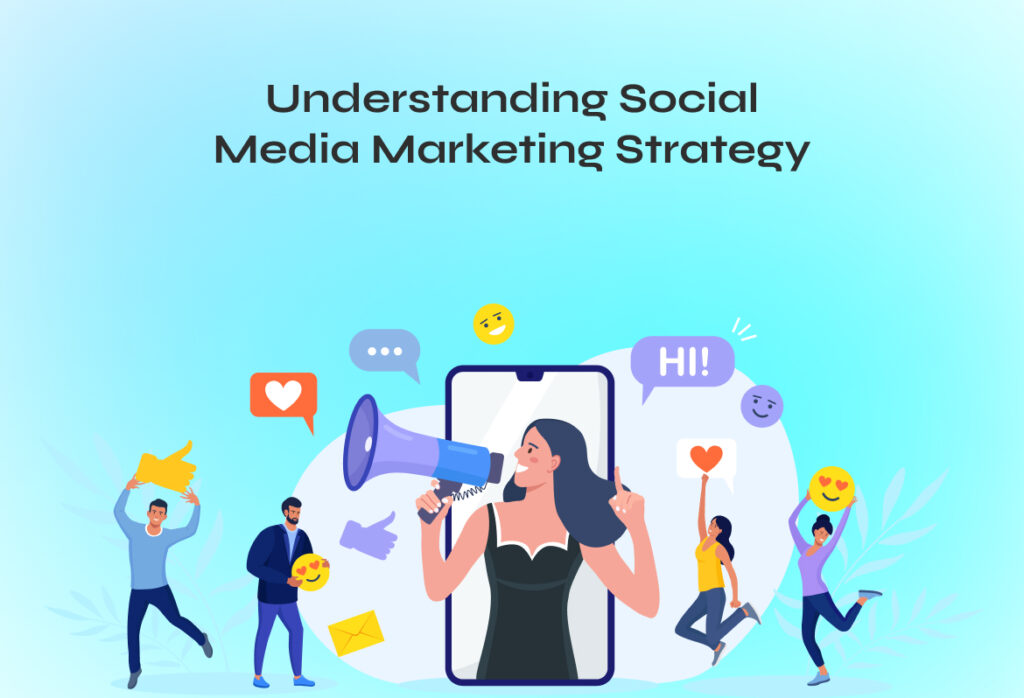In 2024, developing a content strategy has become more crucial than ever. As businesses and creators vie for attention in an overcrowded digital space, a well-crafted content strategy stands out as a beacon of relevance and engagement. This article will walk you through the complex paths of creating a comprehensive content strategy, from understanding its core elements to executing a plan that resonates with your audience, integrates SEO best practices, and leverages social media platforms effectively.
Let’s try to understand how content strategy works and explore how to build a robust framework that aligns with your goals in 2024.
What is Content Strategy
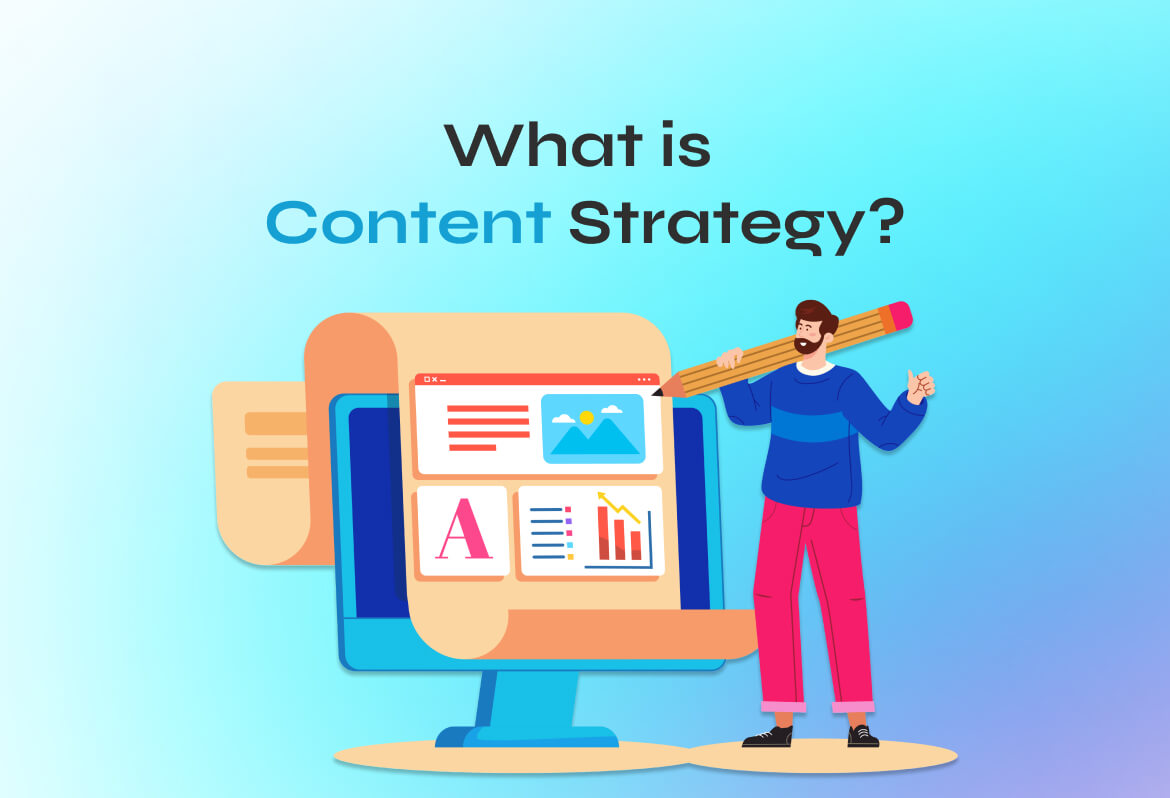
Before diving into the mechanics of building a content strategy, it’s crucial to grasp what it entails. At the simplest, content strategy involves planning, developing, and managing content (written or in other media forms) to achieve specific business and marketing goals. It’s a comprehensive approach that not only considers the creation of content but also its publication and governance.
Content strategy is all about what you say, but how, when, and to whom you say it. In 2024, with the markets and digital world more segmented and personalized than ever, a content strategy helps ensure that your message reaches the right audience, with the right message, at the right time, through the right channels.
A robust content strategy is crucial for several reasons:
- Audience Engagement: It enables you to create content that resonates with your audience, increasing engagement and loyalty.
- Brand Consistency: It helps maintain a consistent brand voice across all your content, enhancing brand recognition and trust.
- SEO Optimization: A well-thought-out strategy includes SEO best practices, making your content more visible and accessible through search engines.
- Resource Efficiency: By planning your content creation and distribution in advance, you can allocate resources more efficiently and avoid last-minute rushes.
Understanding your social media content strategy as a dynamic, integral part of your marketing efforts is the first step toward developing a plan that not only speaks to your audience but also drives them to action. It’s about creating a narrative for your brand that lives and evolves across all your marketing channels.
The Core Elements of Content Strategy
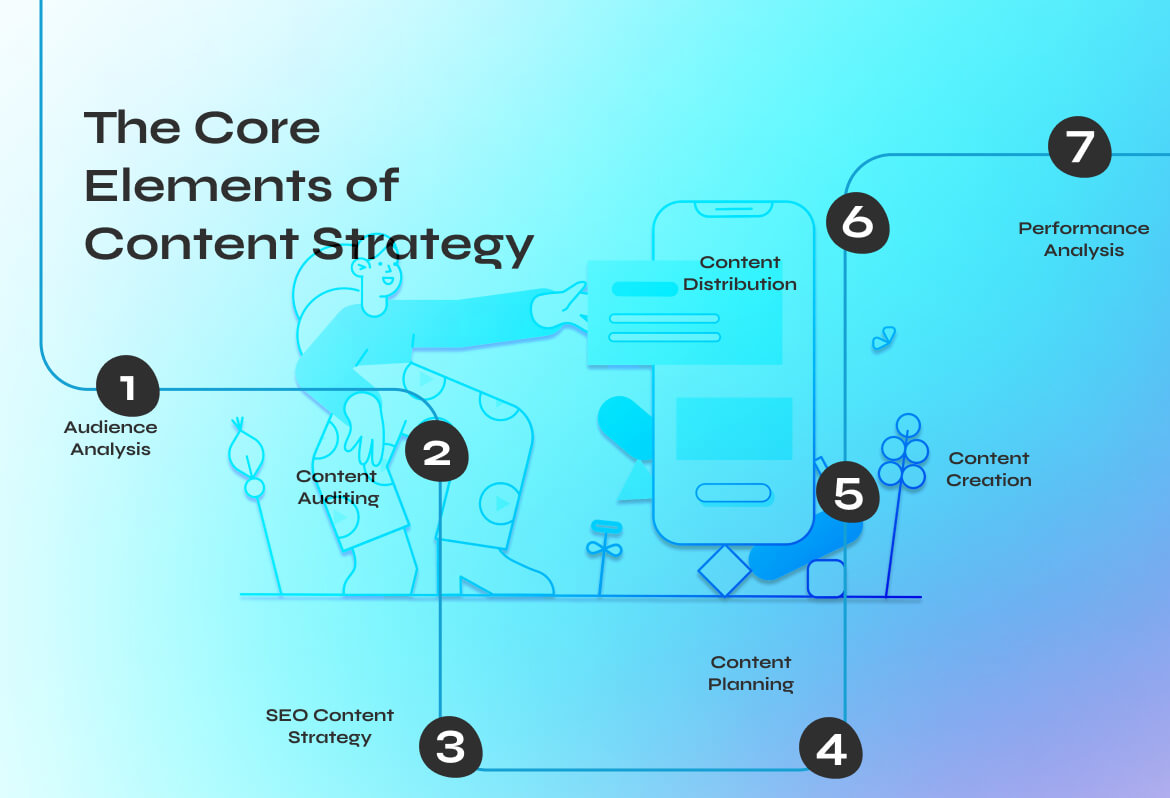
Developing a content strategy involves several key components, each playing a vital role in the overall effectiveness of your marketing efforts. Let’s break down these core elements:
- Audience Analysis: The cornerstone of any content strategy is understanding who your audience is. This involves demographic research, identifying customer pain points, preferences, and behaviors. Knowing your audience allows you to tailor your content to meet their needs and interests.
- Content Auditing: Before you can plan where you’re going, you need to know where you stand. A content audit involves reviewing all your existing content to assess its quality, relevance, and performance. This step helps identify gaps in your content library and opportunities for improvement.
- SEO Content Strategy: In the digital age, visibility is paramount. An SEO content strategy focuses on incorporating keywords, optimizing meta tags, and creating high-quality, relevant content that ranks well in search engine results. It’s about understanding what your audience is searching for and how you can meet those needs through your content.
- Content Planning: This involves deciding on the types of content you will produce (blog posts, videos, podcasts, etc.) and the channels for distribution (website, social media, email newsletters). Effective content planning ensures that your content serves a strategic purpose and aligns with your overall marketing goals.
- Content Creation: At the heart of your strategy is content creation. This step involves producing content that is engaging, informative, and aligned with your brand’s voice and style. Whether it’s writing articles, creating videos, or designing infographics, the focus is on quality and relevance.
- Content Distribution: Creating great content is just one part of the equation. You also need to get it in front of your audience. Content distribution involves selecting the right platforms (social media, email, blogs) and strategies (organic, paid promotion) to share and amplify your content.
- Performance Analysis: Finally, measuring the success of your content is crucial. This involves analyzing metrics like engagement rates, website traffic, and conversion rates to understand what’s working and what’s not. Performance analysis helps you refine and adapt your content strategy over time for better results.
Each of these elements contributes to the overall success of your content strategy, ensuring that your content not only reaches your target audience but also engages and converts them.
Step-by-Step Guide to Developing Your Content Strategy
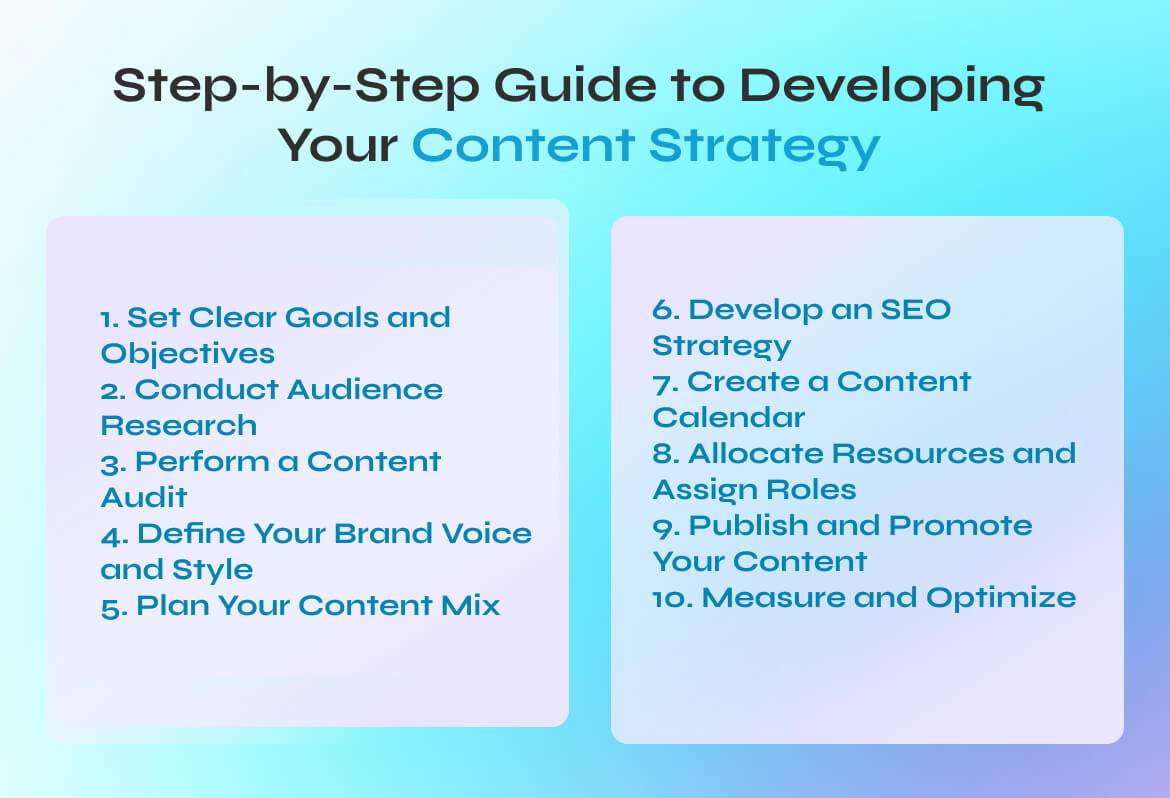
Developing a content strategy from scratch might seem daunting, but by following a systematic approach, you can create a comprehensive plan that aligns with your business objectives and speaks to your audience. Here’s a step-by-step guide to developing your content strategy in 2024
Step 1: Set Clear Goals and Objectives
Begin by defining what you want to achieve with your content strategy. Goals could range from increasing brand awareness, generating leads, boosting sales, or improving customer engagement. Ensure these goals are SMART: Specific, Measurable, Achievable, Relevant, and Time-bound.
Step 2: Conduct Audience Research
To create content that resonates, you must understand who your audience is. Conduct research to gather insights into their demographics, interests, pain points, and online behavior. Use surveys, social media analytics, and customer feedback to build detailed audience personas.
Step 3: Perform a Content Audit
Review your existing content to evaluate its effectiveness and relevance. Identify content that performed well, content that needs updating, and gaps that new content can fill. This step helps you leverage what works and avoid past mistakes.
Step 4: Define Your Brand Voice and Style
Your content should reflect a consistent brand voice and style that resonates with your target audience and differentiates you from competitors. Whether it’s professional, casual, informative, or entertaining, consistency in tone and style builds brand recognition and loyalty.
Step 5: Plan Your Content Mix
Decide on the types of content you’ll create, considering the preferences of your audience and the goals of your strategy. Your mix might include blog posts, videos, podcasts, infographics, and social media posts. Consider the customer journey and plan content that caters to each stage, from awareness to decision-making.
Step 6: Develop an SEO Strategy
Integrate SEO best practices into your content planning to ensure your content is discoverable online. Keyword research, on-page optimization (like meta tags and headings), and quality backlinks are crucial. Stay updated with the latest SEO trends and algorithm updates to keep your content strategy effective.
Step 7: Create a Content Calendar
Organize your content creation and publication schedule with a content calendar. This tool helps you plan your content in advance, ensuring a consistent content flow and timely execution of your strategy. Include details like topics, content formats, responsible team members, and publication channels.
Step 8: Allocate Resources and Assign Roles
Identify the resources (budget, tools, and team members) needed to execute your content strategy successfully. Assign roles and responsibilities, ensuring clear accountability for content creation, distribution, and performance analysis.
Step 9: Publish and Promote Your Content
With your content ready, it’s time to publish and promote it across your chosen platforms. Use your content calendar to guide the publication schedule. Promote your content through social media, email newsletters, and paid advertising to reach a wider audience and drive engagement.
Step 10: Measure and Optimise
Continuously monitor the performance of your content against your goals. Use analytics tools to track engagement, traffic, conversions, and other key metrics. Based on this data, optimize your content strategy by doing more of what works and improving or discontinuing what doesn’t.
Special Focus: SEO Content Strategy in 2024

In 2024, SEO remains a cornerstone of any effective content strategy. As search algorithms become more sophisticated, integrating SEO best practices into your content creation process is crucial. This means going beyond keyword stuffing to focus on creating high-quality, valuable content that addresses the needs and questions of your audience. Utilize long-tail keywords to target specific queries, optimize for voice search by including conversational phrases, and ensure your website’s technical SEO is up to par for optimal user experience. Keeping abreast of SEO trends and algorithm updates is essential for maintaining your content’s visibility and effectiveness.
Leveraging Social Media Content Strategy
Social media platforms are invaluable for amplifying your content’s reach and engaging with your audience. Each platform has its unique audience and content preferences, so tailor your content accordingly. Use engaging visuals, concise and compelling text, and interactive elements like polls and stories to increase engagement. Analyze each platform’s performance metrics to understand what content resonates with your audience, and adjust your strategy to leverage these insights. In 2024, authenticity and community building are key on social media, so focus on creating genuine connections with your audience.
Common Challenges and How to Overcome Them
Even the best-laid content strategies can face challenges. A common issue is producing consistent, high-quality content. To combat this, maintain a content calendar and batch-produce content to avoid last-minute rushes. Another challenge is staying updated with SEO and social media trends. Dedicate time for continuous learning and leverage tools and resources that keep you informed. Finally, measuring content effectiveness can seem daunting. Focus on a few key metrics that align with your goals, and use analytics tools to track progress and inform strategy adjustments. Overcoming these challenges requires planning, flexibility, and a commitment to continuous improvement.
FAQ's
What is a content strategy?
It’s a plan for creating, publishing, and managing useful and relevant content to meet specific business objectives and satisfy audience needs.
Why is a content strategy important in 2024?
As digital competition intensifies, a content strategy helps businesses stand out, reach their target audience effectively, and achieve their marketing and sales goals.
How do I start developing a content strategy?
Begin by setting clear goals, understanding your audience, conducting a content audit, and then planning your content creation and distribution accordingly.
What are the key elements of a content strategy?
Audience research, content auditing, SEO integration, content planning and creation, distribution, and performance analysis are fundamental.
How can I create content that stands out?
Focus on originality, quality, and relevance. Understand your audience’s needs and preferences, and offer unique insights or solutions.
What role does SEO play in a content strategy?
SEO makes your content more visible and discoverable online, driving traffic to your website and increasing engagement.
Can I use social media for my content strategy?
Absolutely. Social media platforms are key channels for promoting your content, engaging with your audience, and expanding your reach.
How often should I review or update my content strategy?
Regularly. It’s advisable to review your strategy quarterly and make adjustments based on performance data and any shifts in your business goals or audience behavior.
What if my content isn't performing well?
Analyze performance metrics to identify issues. Consider revising your content, experimenting with different formats or channels, and enhancing your SEO tactics.
Do I need a big budget to implement a content strategy?
Not necessarily. Creativity and strategic planning can compensate for limited budgets. Focus on quality over quantity and leverage free or low-cost tools and platforms.
Conclusion
Developing a content strategy in 2024 requires a focused approach that integrates audience understanding, SEO optimization, and social media engagement. By setting clear goals, understanding your audience, creating valuable content, and continuously optimizing based on performance data, you can build a strategy that not only reaches your target audience but also drives meaningful engagement and achieves your business objectives. Remember, the digital landscape is ever-evolving, so stay adaptable, keep learning, and iterate on your strategy for sustained success. Your content strategy is not just about reaching your audience today but growing with them into the future.

